
A locomotive or engine is a rail transport vehicle that provides the motive power for a train. If a locomotive is capable of carrying a payload, it is usually rather referred to as a multiple unit, motor coach, railcar or power car;

The British Rail Class 89 is a prototype electric locomotive. Only one was built, in 1986, by British Rail Engineering Limited's Crewe Works. It was used on test-trains on both the West Coast and East Coast Main Lines. The locomotive was fitted with advanced power control systems and developed more than 6,000 bhp. After being withdrawn in 1992, it was returned to service in 1996, before being again withdrawn in 2000. As of January 2021, it is in the final stages of an overhaul that will return it to the main line.
A number of different numbering and classification schemes were used for locomotives and multiple units operated by British Railways (BR), and this page explains the principal systems. This section also covers the post-privatisation period, as the broad numbering and classification arrangements have not altered since the break-up of BR.

HS4000 Kestrel was a prototype high-powered mainline diesel locomotive that was built in 1967 by Brush Traction, Loughborough, as a technology demonstrator for potential future British Rail and export orders. The locomotive number is a combination of the initials of Hawker Siddeley and the power rating of its Sulzer diesel engine (4,000 hp), making it the most powerful locomotive built by the company.
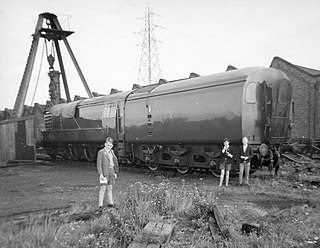
GT3 was a prototype mainline gas turbine locomotive built in 1961 by English Electric at its Vulcan Foundry in Newton-le-Willows to investigate the use of its gas turbines in rail traction applications. It followed 18000 and 18100 as gas turbines 1 and 2. It was designed by English Electric engineer J. O. P. Hughes in a project that started in the early 1950s. Externally it resembled a steam tender locomotive, but the tender carried kerosene fuel. The designer said the traditional chassis and mechanical transmission avoided complications with relatively untried technologies for bogies and electrical transmission.

British Rail 18000 was a prototype mainline gas turbine-electric locomotive built for British Railways in 1949 by Brown, Boveri & Cie. An earlier gas-turbine locomotive, 18100, had been ordered from Metropolitan-Vickers by the Great Western Railway but construction was delayed due to World War II; a second, 18000, was thus ordered from Switzerland in 1946. It spent its working life on the Western Region of British Railways, operating express passenger services from Paddington station, London.
Metropolitan-Vickers, Metrovick, or Metrovicks, was a British heavy electrical engineering company of the early-to-mid 20th century formerly known as British Westinghouse. Highly diversified, it was particularly well known for its industrial electrical equipment such as generators, steam turbines, switchgear, transformers, electronics and railway traction equipment. Metrovick holds a place in history as the builders of the first commercial transistor computer, the Metrovick 950, and the first British axial-flow jet engine, the Metropolitan-Vickers F.2. Its factory in Trafford Park, Manchester, was for most of the 20th century one of the biggest and most important heavy engineering facilities in Britain and the world.

The British Rail Class 44 or Sulzer Type 4 diesel locomotives were built by British Railways' Derby Works between 1959 and 1960, intended for express passenger services. They were originally numbered D1-D10 and named after mountains in England and Wales, and, along with the similar Class 45 and 46 locomotives, they became known as Peaks.
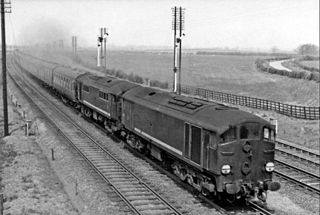
The British Rail Class 28 diesel-electric locomotives, known variously as 'Metrovicks', 'Crossleys' or 'Co-Bos', were built under the Pilot Scheme for diesel locomotives as part of the British Railways 1955 Modernisation Plan.

The Eurotunnel Class 9 or Class 9000 are six-axle high-power Bo′Bo′Bo′ single-ended electric locomotives built by the Euroshuttle Locomotive Consortium (ESCL) of Brush Traction and ABB. The class was designed for and is used exclusively to haul the LeShuttle road vehicle services through the Channel Tunnel.

The British Rail Class 82 electric locomotives were designed by the British manufacturing interest Metropolitan-Vickers and produced by Beyer, Peacock and Company on behalf of British Rail (BR).

The British Rail Class 84 was a 25 kV AC electric locomotive that operated on the West Coast Main Line (WCML) of the London Midland Region.
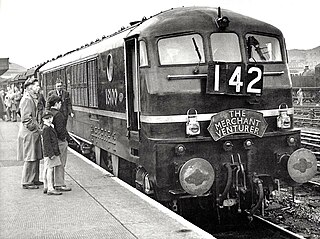
British Rail 18100 was a prototype main line gas turbine-electric locomotive built for British Railways in 1951 by Metropolitan-Vickers, Manchester. It had, however, been ordered by the Great Western Railway in the 1940s, but construction was delayed due to World War II. It spent its working life on the Western Region of British Railways, operating express passenger services from Paddington station, London.
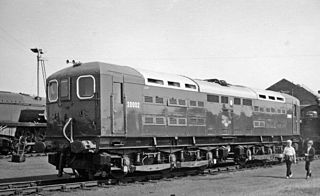
The British Rail Class 70 was a class of three third rail Co-Co electric locomotives. The initial two were built by the Southern Railway (SR) at Ashford Works in 1940–41 and 1945 and were numbered CC1 and CC2 - the Southern Railway latterly preferring French practice for locomotive numbers which also gave an indication of the wheel arrangement. Electrical equipment was designed by Alfred Raworth and the body and bogies by Oliver Bulleid. CC2 was modified slightly from the original design by C. M. Cock who had succeeded Raworth as electrical engineer. The third was built by British Railways in 1948 and numbered 20003.

Co-Co is the wheel arrangement for diesel and electric locomotives with two six-wheeled bogies with all axles powered, with a separate traction motor per axle. The equivalent UIC classification (Europe) for this arrangement is Co′Co′, or C-C for AAR.
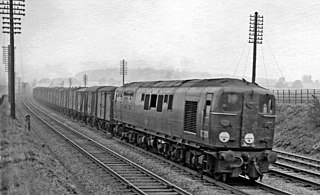
British Railways Class D16/2 was a class of prototype diesel locomotives built by British Railways at Ashford Works and introduced in 1950–1951, with a third example being introduced in 1954. They had been designed by Oliver Bulleid for the Southern Railway and were authorised in February 1947 but did not appear until after nationalisation. The diesel engine and transmission were supplied by English Electric, but the Bulleid influence was obvious. The box-like body style closely resembled Bulleid's electric locomotives and was quite different from the usual English Electric style, typified by British Rail Class D16/1 which in turn was strongly influenced by contemporary American design.

British Railways 10800 was a diesel locomotive built by the North British Locomotive Company for British Railways in 1950. It had been ordered by the London, Midland and Scottish Railway in 1946 but did not appear until after the 1948 nationalisation of the railways.
Bowesfield Works was a railway locomotive manufacturing plant in Stockton-on-Tees. The works was operated by a joint venture company called Metropolitan Vickers-Beyer Peacock from 1949 until 1960.
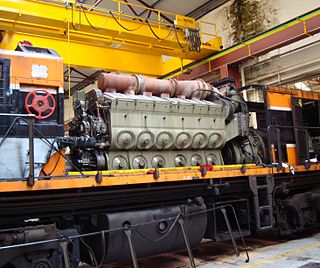
In engineering, a prime mover is an engine that converts chemical energy of a fuel into useful work. In a locomotive, the prime mover is thus the source of power for its propulsion. In an engine-generator set, the engine is the prime mover, as distinct from the generator.

Rigid-framed electric locomotives were some of the first generations of electric locomotive design. When these began the traction motors of these early locomotives, particularly with AC motors, were too large and heavy to be mounted directly to the axles and so were carried on the frame. One of the initial simplest wheel arrangements for a mainline electric locomotive, from around 1900, was the 1′C1′ arrangement, in UIC classification.


















